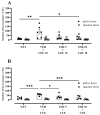Esketamine Inhibits Cocaine-Seeking Behaviour Subsequent to Various Abstinence Conditions in Rats
- PMID: 37759811
- PMCID: PMC10527312
- DOI: 10.3390/biom13091411
Esketamine Inhibits Cocaine-Seeking Behaviour Subsequent to Various Abstinence Conditions in Rats
Abstract
Background: Cocaine use disorder (CUD) is a relapsing brain disease caused by a chronic drug intake that involves neural mechanisms and psychological processes, including depression. Preclinical and clinical studies have demonstrated the promise of pharmacological drugs in controlling the reinstatement of cocaine by targeting the N-methyl-D-aspartate (NMDA) receptor. Recent evidence has revealed that esketamine, a (S) enantiomer of ketamine, shows a high affinity to NMDA receptors and has been used in clinical trials to treat moderate-to-severe depression.
Methods: In the present paper, we investigated the effects of esketamine in regulating cocaine-seeking behaviour induced through the use of cocaine (10 mg/kg) or the cocaine-associated conditioned cue after a short (10 days)-lasting period of drug abstinence with extinction training, home cage or enrichment environment conditions in male rats. Furthermore, we investigated the acute effects of esketamine on locomotor activity in drug-naïve animals.
Results: Esketamine (2.5-10 mg/kg) administered peripherally attenuated the reinstatement induced with cocaine priming or the drug-associated conditioned cue after different conditions of abstinence.
Conclusions: These results seem to support esketamine as a candidate for the pharmacological management of cocaine-seeking and relapse prevention; however, further preclinical and clinical research is needed to better clarify esketamine's actions in CUD.
Keywords: cocaine abstinence; cocaine-seeking behaviour; esketamine; rats.
© 2023 by the authors.
Conflict of interest statement
The authors declare no conflict of interest.
Figures





Similar articles
-
Prescription of Controlled Substances: Benefits and Risks.2025 Jul 6. In: StatPearls [Internet]. Treasure Island (FL): StatPearls Publishing; 2025 Jan–. 2025 Jul 6. In: StatPearls [Internet]. Treasure Island (FL): StatPearls Publishing; 2025 Jan–. PMID: 30726003 Free Books & Documents.
-
Sex specific effects of ketamine, but not other glutamate receptor modulators, on ethanol self-administration and reinstatement of ethanol seeking in rats.Psychopharmacology (Berl). 2025 Sep;242(9):2035-2045. doi: 10.1007/s00213-025-06782-2. Epub 2025 Apr 8. Psychopharmacology (Berl). 2025. PMID: 40198329
-
Dopamine transmission at D1 and D2 receptors in the nucleus accumbens contributes to the expression of incubation of cocaine craving.Neuropsychopharmacology. 2024 Dec;50(2):461-471. doi: 10.1038/s41386-024-01992-2. Epub 2024 Sep 19. Neuropsychopharmacology. 2024. PMID: 39300272
-
The Black Book of Psychotropic Dosing and Monitoring.Psychopharmacol Bull. 2024 Jul 8;54(3):8-59. Psychopharmacol Bull. 2024. PMID: 38993656 Free PMC article. Review.
-
Ketamine and other glutamate receptor modulators for depression in adults with unipolar major depressive disorder.Cochrane Database Syst Rev. 2021 Sep 12;9(9):CD011612. doi: 10.1002/14651858.CD011612.pub3. Cochrane Database Syst Rev. 2021. PMID: 34510411 Free PMC article.
Cited by
-
Is there a risk of esketamine misuse in clinical practice?Ther Adv Drug Saf. 2025 Jan 29;16:20420986241310685. doi: 10.1177/20420986241310685. eCollection 2025. Ther Adv Drug Saf. 2025. PMID: 39882342 Free PMC article. Review.
-
Further proof on the role of accumbal nNOS in cocaine-seeking behavior in rats.Pharmacol Rep. 2024 Apr;76(2):338-347. doi: 10.1007/s43440-024-00571-y. Epub 2024 Mar 14. Pharmacol Rep. 2024. PMID: 38480667
-
Abuse liability for esketamine in a cohort of patients undergoing an acute treatment course to manage treatment-resistant depression: a secondary analysis of an observational study in real-world clinical practicee.Ther Adv Drug Saf. 2025 Jun 19;16:20420986251347360. doi: 10.1177/20420986251347360. eCollection 2025. Ther Adv Drug Saf. 2025. PMID: 40546784 Free PMC article.
References
Publication types
MeSH terms
Substances
LinkOut - more resources
Full Text Sources
Medical

